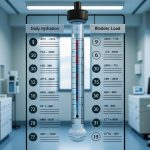Maintaining proper hydration is fundamental to overall health, yet the concept often gets oversimplified. We’re frequently told to “drink more water,” but rarely are we given nuanced guidance on how to manage fluid intake effectively, especially when considering individual needs and varying circumstances. A key challenge lies in balancing sufficient hydration with avoiding excessive fluid load, which can be detrimental. Many individuals unknowingly struggle with retaining too much fluid – a condition often exacerbated by underlying health issues or lifestyle factors – leading to discomfort and potentially serious complications. This article explores the intricacies of managing fluid balance without inadvertently causing dehydration, focusing on understanding individual needs and adopting practical strategies for optimal hydration.
The human body is approximately 55% to 78% water, depending on age, sex, and body composition. This water isn’t merely present; it’s actively involved in countless physiological processes – from regulating body temperature and transporting nutrients to flushing out waste products and lubricating joints. Achieving the right fluid balance isn’t about hitting a specific daily number (although guidelines exist), but rather responding to your body’s signals and adjusting intake based on activity level, climate, health status, and even dietary choices. Ignoring these factors can lead to both dehydration and overhydration, highlighting the need for mindful hydration practices.
Understanding Fluid Balance & Retention
Fluid retention, often referred to as edema, isn’t always a sign of excessive water intake; it’s more frequently related to underlying medical conditions or lifestyle habits. Conditions like heart failure, kidney disease, liver cirrhosis, and venous insufficiency can all contribute to fluid buildup in the body. However, even without an existing health condition, several factors can promote retention: prolonged standing or sitting, high sodium intake, hormonal changes (particularly in women), and certain medications. Recognizing these potential causes is crucial for developing a targeted approach to fluid management. It’s important to note that swelling isn’t always indicative of excess fluids; it could also signal inflammation or injury.
The kidneys play a pivotal role in regulating fluid balance. They filter blood, removing waste products and adjusting the amount of water reabsorbed back into the bloodstream. When kidney function is compromised, this delicate process can be disrupted, leading to fluid retention. Similarly, imbalances in electrolytes – sodium, potassium, and magnesium – directly impact how the body holds onto or releases fluids. Sodium, in particular, causes the body to retain water; therefore, reducing sodium intake can often help minimize fluid buildup. This isn’t about eliminating sodium entirely, but rather being mindful of consumption and choosing whole, unprocessed foods whenever possible. You might also find it useful to explore how to cut sodium without losing meal taste for a more enjoyable approach.
Ultimately, achieving a healthy fluid balance is about listening to your body. Signs of dehydration include thirst, dark urine, fatigue, dizziness, and decreased urination. Conversely, signs of overhydration can encompass bloating, swelling (especially in the ankles and feet), nausea, headache, and confusion. Pay attention to these cues and adjust your intake accordingly. Remember that individual needs vary significantly; there’s no one-size-fits-all solution.
Strategies for Optimized Hydration
Optimized hydration is about more than simply drinking water. It’s a holistic approach encompassing mindful intake, strategic timing, and consideration of dietary sources. Here are some strategies to help you manage fluid load effectively without inadvertently dehydrating:
- Prioritize Water Throughout the Day: Don’t wait until you feel thirsty to drink; sip water consistently throughout the day. Keep a reusable water bottle handy as a visual reminder.
- Electrolyte Balance: Ensure adequate electrolyte intake, particularly sodium, potassium, and magnesium. These can be obtained through a balanced diet or, in some cases, electrolyte-rich beverages (but avoid sugary sports drinks).
- Dietary Fluid Sources: Incorporate fluid-rich foods into your diet – fruits like watermelon and oranges, vegetables like cucumbers and celery, and soups/broths.
Consider incorporating foods that support kidney drainage into your diet to further aid in fluid balance.
Recognizing & Addressing Underlying Issues
Fluid retention is often a symptom rather than the problem itself. Identifying and addressing underlying medical conditions is paramount. If you experience persistent swelling or suspect kidney issues, consult with a healthcare professional for diagnosis and appropriate treatment. Ignoring these symptoms can lead to more severe complications. This may involve blood tests to assess kidney function, electrolyte levels, and overall health status.
Furthermore, lifestyle modifications can play a significant role in managing fluid retention. Reducing sodium intake is often the first step, followed by regular exercise (which promotes circulation) and elevating your legs when resting to minimize swelling. Avoiding prolonged standing or sitting can also help. It’s crucial not to self-treat with diuretics without medical supervision, as these medications can have side effects and may interact with other medications you’re taking.
The Role of Individual Factors & Monitoring
Each individual has unique hydration needs based on various factors. Age, activity level, climate, health status, and even body composition all play a role. Athletes, for example, require significantly more fluids than sedentary individuals. People living in hot climates also need to increase their intake. Similarly, individuals with certain medical conditions may have specific fluid restrictions or requirements dictated by their healthcare provider.
Monitoring your body’s response is key. Pay attention to urine color (pale yellow indicates adequate hydration), frequency of urination, and any signs of swelling. Keeping a hydration journal – tracking your fluid intake, activity level, and any symptoms you experience – can help identify patterns and inform adjustments to your hydration strategy. Don’t rely solely on generic recommendations; tailor your approach to your specific needs and consult with a healthcare professional if you have concerns or underlying health conditions. To better understand your body’s signals, explore tracking behavioral flow patterns without relying on complicated devices.
It’s also beneficial to learn about hydration awareness without fear or overcorrection, focusing on a balanced and intuitive approach.
Understanding how to manage fluid intake can be further enhanced by exploring how to rehydrate without flooding the bladder, ensuring optimal hydration without discomfort.
Finally, consider implementing strategies for midday fluid planning to prevent evening discomfort and promote a more restful night’s sleep.





















